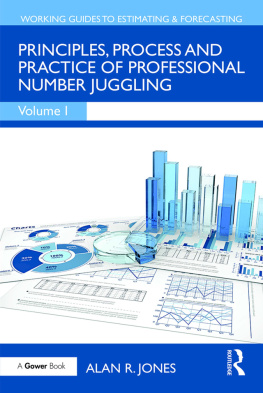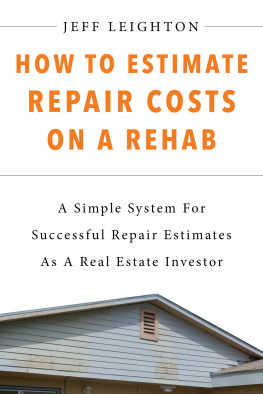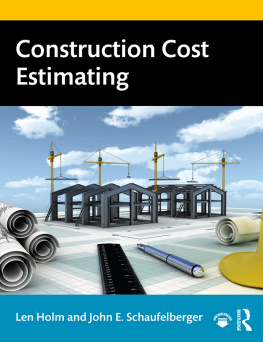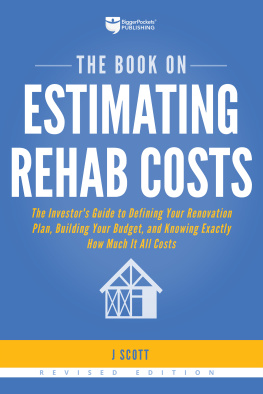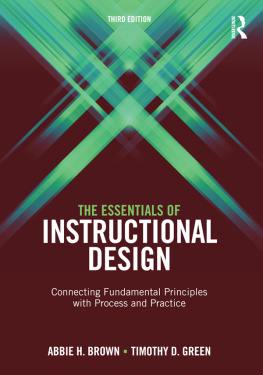In the Working Guides to Estimating and Forecasting Alan has managed to capture the full spectrum of relevant topics with simple explanations, practical examples and academic rigor, while injecting humour into the narrative.
Dale Shermon , Chairman, Society of Cost Analysis and Forecasting (SCAF)
If estimating has always baffled you, this innovative well illustrated and user friendly book will prove a revelation to its mysteries. To confidently forecast, minimise risk and reduce uncertainty we need full disclosure into the science and art of estimating. Thankfully, and at long last the Working Guides to Estimating & Forecasting are exactly that, full of practical examples giving clarity, understanding and validity to the techniques. These are comprehensive step by step guides in understanding the principles of estimating using experientially based models to analyse the most appropriate, repeatable, transparent and credible outcomes. Each of the five volumes affords a valuable tool for both corporate reference and an outstanding practical resource for the teaching and training of this elusive and complex subject. I wish I had access to such a thorough reference when I started in this discipline over 15 years ago, I am looking forward to adding this to my library and using it with my team.
Tracey L Clavell , Head of Estimating & Pricing, BAE Systems Australia
At last, a comprehensive compendium on these engineering math subjects, essential to both the new and established cost engineer! As expected the subjects are presented with the authors usual wit and humour on complex and daunting mathematically challenging subjects. As a professional trainer within the MOD Cost Engineering community trying to embed this into my students, I will be recommending this series of books as essential bedtime reading.
Steve Baker , Senior Cost Engineer, DE&S MOD
Alan has been a highly regarded member of the Cost Estimating and forecasting profession for several years. He is well known for an ability to reduce difficult topics and cost estimating methods down to something that is easily digested. As a master of this communication he would most often be found providing training across the cost estimating and forecasting tools and at all levels of expertise. With this 5-volume set, Working Guides to Estimating and Forecasting , Alan has brought his normal verbal training method into a written form. Within their covers Alan steers away from the usual dry academic script into establishing an almost 1:1 relationship with the reader. For my money a recommendable read for all levels of the Cost Estimating and forecasting profession and those who simply want to understand what is in the blackbox just a bit more.
Prof Robert Mills , Margin Engineering, Birmingham City University. MACOSTE, SCAF, ICEAA
Finally, a book to fill the gap in cost estimating and forecasting! Although other publications exist in this field, they tend to be light on detail whilst also failing to cover many of the essential aspects of estimating and forecasting. Jones covers all this and more from both a theoretical and practical point of view, regularly drawing on his considerable experience in the defence industry to provide many practical examples to support his comments. Heavily illustrated throughout, and often presented in a humorous fashion, this is a must read for those who want to understand the importance of cost estimating within the broader field of project management.
Dr Paul Blackwell , Lecturer in Management of Projects, The University of Manchester, UK
Alan Jones provides a useful guidebook and navigation aid for those entering the field of estimating as well as an overview for more experienced practitioners. His humorous asides supplement a thorough explanation of techniques to liven up and illuminate an area which has little attention in the literature, yet is the basis of robust project planning and successful delivery. Alans talent for explaining the complicated science and art of estimating in practical terms is testament to his knowledge of the subject and to his experience in teaching and training.
Therese Lawlor-Wright , Principal Lecturer in Project Management at the University of Cumbria
Alan Jones has created an in depth guide to estimating and forecasting that I have not seen historically. Anyone wishing to improve their awareness in this field should read this and learn from the best.
Richard Robinson , Technical Principal for Estimating, Mott MacDonald
The book series of Working Guides to Estimating and Forecasting is an essential read for students, academics and practitioners who interested in developing a good understanding of cost estimating and forecasting from real-life perspectives.
Professor Essam Shehab , Professor of Digital Manufacturing and Head of Cost Engineering, Cranfield University, UK
In creating the Working Guides to Estimating and Forecasting, Alan has captured the core approaches and techniques required to deliver robust and reliable estimates in a single series. Some of the concepts can be challenging, however, Alan has delivered them to the reader in a very accessible way that supports lifelong learning. Whether you are an apprentice, academic or a seasoned professional, these working guides will enhance your ability to understand the alternative approaches to generating a well-executed, defensible estimate, increasing your ability to support competitive advantage in your organisation.
Professor Andrew Langridge , Royal Academy of Engineering Visiting Professor in Whole Life Cost Engineering and Cost Data Management, University of Bath, UK
Alan Joness Working Guides to Estimating and Forecasting provides an excellent guide for all levels of cost estimators from the new to the highly experienced. Not only does he cover the underpinning good practice for the field, his books will take you on a journey from cost estimating basics through to how estimating should be used in manufacturing the future reflecting on a whole life cycle approach. He has written a must-read book for anyone starting cost estimating as well as for those who have been doing estimates for years. Read this book and learn from one of the best.
Linda Newnes , Professor of Cost Engineering, University of Bath, UK
Principles, Process and Practice of Professional Number Juggling
Principles, Process and Practice of Professional Number Juggling (Volume 1 of the Working Guides to Estimating & Forecasting series) sets the scene of TRACEability and good estimate practice that is followed in the other volumes in this series of five working guides. It clarifies the difference between an Estimating Process, Procedure, Approach, Method and Technique. It expands on these definitions of Approach (Top-down, Bottom-up and Ethereal) and Method (Analogy, Parametric and Trusted Source) and discusses how these form the basis of all other means of establishing an estimate.
This volume also underlines the importance of data normalisation in any estimating procedure, and demonstrates that the Estimating by Analogy Method, in essence, is a simple extension of Data Normalisation. The author looks at simple measures of assessing the maturity or health of an estimate, and offers a means of assessing a spreadsheet for any inherent risks or errors that may be introduced by failing to follow good practice in spreadsheet design and build.
This book provides a taster of the more numerical techniques covered in the remainder of the series by considering how an estimator can potentially exploit Benfords Law (traditionally used in Fraud Detection) to identify systematic bias from third party contributors. It will be a valuable resource for estimators, engineers, accountants, project risk specialists as well as students of cost engineering.

